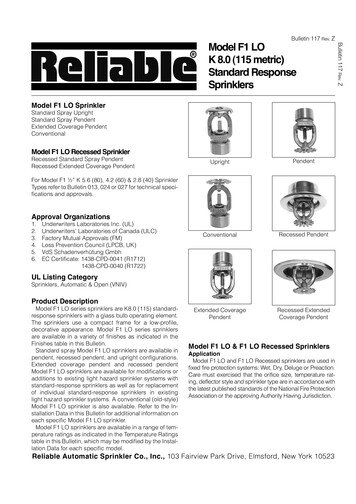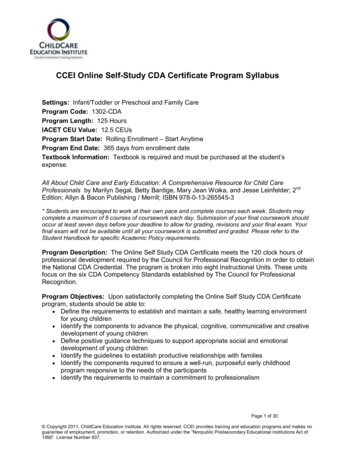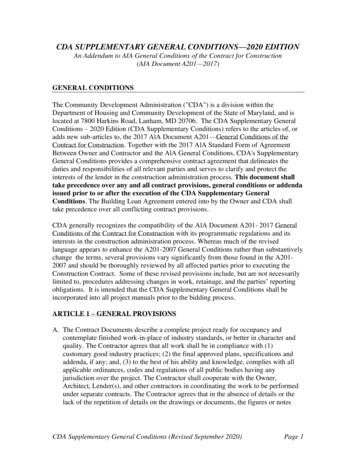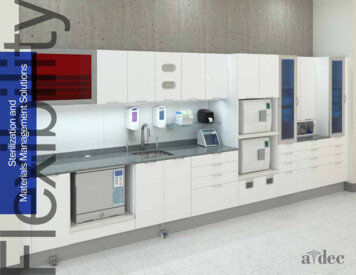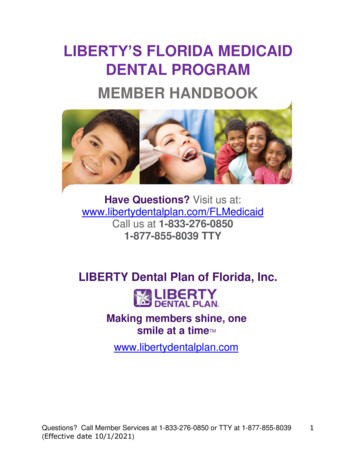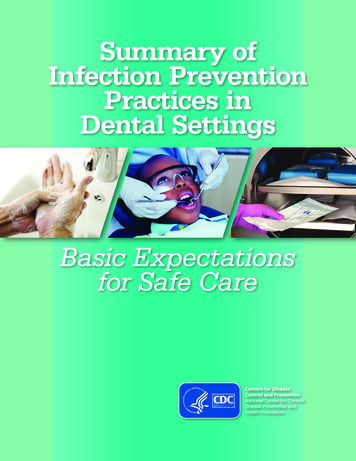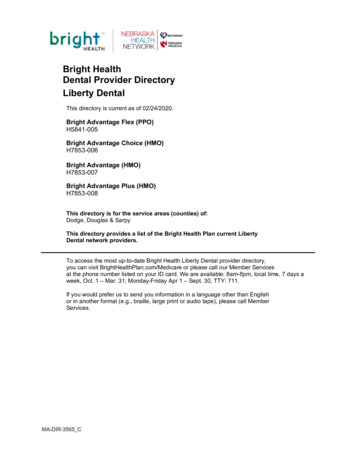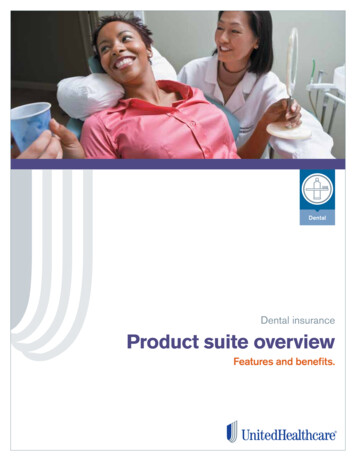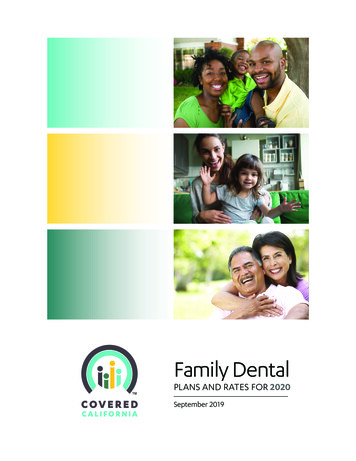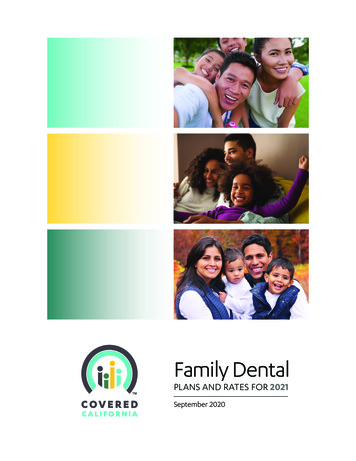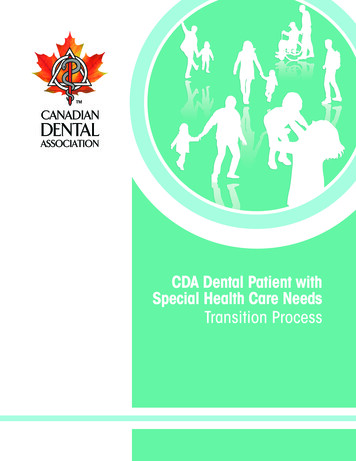
Transcription
CDA Dental Patient withSpecial Health Care NeedsTransition Process
CDA DENTAL PATIENT WITH SPECIAL HEALTH CARE NEEDSTRANSITION PROCESSExecutive SummaryIn dentistry, when a young person approaches or reaches age 18, they usually transfer from a pediatricdentist to a general dentist who will continue to provide them with oral health care as adults in a newdental home. This process is called transition.Dental and health care teams currently manage this transition in a variety of ways. The Canadian DentalAssociation’s (CDA) National Coordinating Working Group on Access to Care (Working Group)—incollaboration* with community-based pediatric dentists, general dentists, and a parent—adapted anevidence-based, adolescent-to-adult transition process from a medical setting in the United States. Itis based on best practices for persons with special health care needs (SHCN) and creates a consistenttransition process for the Canadian oral health care environment. These adapted best practices canbe used in any SHCN patient group for assisting in transitioning young people into the adult oral healthcare environment.For patients and families/caregivers, a formalized transition process will help guide them through the transferfrom pediatric to adult oral health care smoothly. For dentists and the dental team, following a step-bystep process will help ensure a more organized and consistent clinical protocol for facilitating transitionpreparation and patient transfer. Overall, this will result in a more seamless, patient-centered integrationof young people into oral health care for adults, or when adults move from one dental environment toanother. More importantly, it will improve communication* between the oral health care provider, thepatient and their legally authorized representative(s)*, herein after called “families and caregivers,” andit will enable establishing a better rapport.The CDA Dental Patient with Special Health Care Needs Transition Process consists of three steps that arebased on the Six Core Elements of Health Care Transition 2.0 by Got Transition (Figure 1), created by theCenter for Health Care Transition Improvement and the National Alliance to Advance Adolescent Health.The three steps of the CDA Dental Patient with Special Health Care Needs Transition Process are:Step 1: Transition Readiness AssessmentStep 2: Dental Summary and Care PlanStep 3: Meet and GreetStep 2 includes a form to be prepared by the transferring dentist that usually takes about 15-20 minutes tocomplete. This provides as much information as possible about a patient’s broader life circumstances andpast oral health care to support a successful transition.Some patient medical conditions or terms may be unfamiliar. Helpful videos on a range of topics are linkedthroughout this document and are marked with an asterisk (*). These videos and other useful links are alsoavailable on www.cda-adc.ca/transition. For quick reference, please bookmark this webpage and checkback regularly for new resources.
CDA DENTAL PATIENT WITH SPECIAL HEALTH CARE NEEDSTRANSITION PROCESSPatients with Special Health Care Needs (SHCN)Transitioning to adult oral health care may be challenging for some adolescents and their families/caregivers, especially for individuals with special health care needs. Some patients may find it difficultor uncomfortable to be exposed to new environments, care providers, routines, or sensory experiences.The overall health care for patients with SHCN often involves intensive and/or ongoing supervision andcoordination between medical and dental care teams. A coordinated and planned approach canease the transition process and reduce potential logistical and/or behavioural challenges. It encouragesprioritizing patient goals and independence; it also enables the provider to view the patient as knowingthemselves better than anyone else could.The Power of LanguageLanguage is a powerful tool that can reflect biased attitudes and beliefs. Some words can make a personfeel uplifted or supported, while others can make a person feel disrespected or stigmatized.There are varying opinions about the most appropriate way to describe individuals or groups who live witha disability or other differences. This tool has adopted person-centred language with the goal of providingadvice and making information as broadly useable for oral health care providers as possible.Person-centred language places emphasis on the individual as a whole human being first, not theirdisability, condition, or diagnosis. Using person-centred language helps to avoid the assumption that aperson’s disability or condition is a characteristic of their personal identity, therefore placing the patient’scondition or disability as secondary to who the person is.Some patients may prefer “identity-first” language, such as “autistic person” rather than “a person withautism,” or “disabled person” rather than “person with a disability.” These language preferences arebased on the value an individual places on their disability as being a vital part of who they are, and thecommunity or culture they identify with.As a best practice, the dental team should always ask patients and their families/caregivers to confirmtheir language preferences. Making thoughtful language choices can enhance collaboration and helpstrengthen patient outcomes in terms of meeting their individual oral and overall health goals.Addressing Dentists’ Top Training and Knowledge Needswhen Caring for Patients with SHCNOne of the CDA’s priorities is to advocate for accessible oral health care for all of Canada’s populations,including patient groups who have SHCN. In 2018-19, CDA engaged in research to determine how tofurther improve communication efforts and access to quality oral health care for persons with SHCN. Nearly1,500 dentists across Canada participated in focus groups, in-depth telephone interviews and an onlinesurvey. Dentists shared their views on where they felt they could use further training or support when caringfor persons with SHCN. Developing the CDA Dental Patient with Special Health Care Needs TransitionProcess in part addresses dentists’ top training and knowledge needs when providing oral health care topersons with SHCN.
CONTENTS1. Getting Started 1Goals of the CDA Dental Patient withSpecial Health Care Needs Transition Process 1Nine Essential Guiding Principles of the CDA Dental Patient withSpecial Health Care Needs Transition Process 1Best Practices: Using the CDA Dental Patient withSpecial Health Care Needs Transition Process Package 1Additional Educational Resources: Videos andLinks to Helpful Information 2Shared Accountability 22.CDA Dental Patient with Special Health Care NeedsTransition Process 3Step 1: Transition Readiness Assessment 3Explanation 3Transition Readiness Assessment Tool 4Take Home Letter (Sample for patients who arechildren or adolescents) 6Take Home Letter (Sample for adult patients) 7Step 2: Dental Summary and Care Plan 8Explanation 8Dental Summary and Care Plan Form 9Step 3: Meet and Greet 14Explanation 14Meet and Greet Letter (New Patient Post-Meeting) 15Conclusion 16Glossary of Terms 17References 22
CDA DENTAL PATIENT WITH SPECIAL HEALTH CARE NEEDSTRANSITION PROCESS1. Getting StartedGoals of the CDA Dental Patient with Special Health Care Needs Transition ProcessThe CDA Dental Patient with Special Health Care Needs Transition Process package aims to:1. Guide patients, families/caregivers and oral health care providers seamlessly through the transition process whenan adolescent moves from pediatric to adult oral health care, or when an adult moves from one dental practiceto another;2. Improve a patient’s abilities to better manage their own oral and overall health care;3. Help individuals use oral health care services more effectively; and4. Promote an organized clinical process in pediatric and adult practices to better facilitate: transition preparation; patient transfer; a smooth integration into adult-centred care; and improved communication between the provider and patient/family/caregiver.Nine Essential Guiding Principles of the CDA Dental Patient with Special Health Care NeedsTransition ProcessNine essential guiding principles can help to ensure the wellbeing, safety and quality of care for transitioning patients frompediatric to adult oral health care:1. Adult-centred and recognition of strengths: Importance of the individual with special needs to be adult-centredand focused on their strengths.2. Autonomy: Emphasis on self-determination, self‑management, and family and/or caregiver engagement.3. Awareness: Acknowledgement of individual differences and complexities.4. Recognition: Recognizing vulnerabilities and the need for a distinct population health approach.5. Continuity: Need for early and ongoing preparation, including the integration into an adult model of care.6. Collaboration: Importance of shared accountability, effective communication, and care co-ordination betweenpediatric and adult clinicians and systems of care.7. Culturally aware: Recognition of the influence of cultural beliefs and attitudes as well as socio-economic status.8. Equity: Emphasis on achieving health equity and elimination of disparities.9. Support system: Need for family and caregivers to support individuals in building knowledge regarding their ownhealth care skills in making health related decisions.Best Practices: Using the CDA Dental Patient with Special Health Care Needs TransitionProcess PackageDentists and dental teams are committed to improving transitions of care for their patients, but sometimes are unable to institutea formal program or process for a variety of reasons. Since no standardized process for oral health care transition exists inCanada, the CDA suggests an alternative approach by implementing three steps as part of CDA Dental Patient with SpecialHealth Care Needs Transition Process, which will improve the care-transition process for patients, families/caregivers and thedental team through:Step 1: completing a transition readiness assessment;Step 2: creating a dental summary and care plan; andStep 3: having a meet and greet with the patient. 1
CDA DENTAL PATIENT WITH SPECIAL HEALTH CARE NEEDSTRANSITION PROCESSAdditional Educational Resources: Videos and Links to Helpful InformationAs an oral health care provider, you may feel unfamiliar with some patient conditions or terms that each step of the CDADental Patient with Special Health Care Needs Transition Process may highlight. Do not be worried. This is intentional andpresents an opportunity to learn more about a patient’s specific condition(s) and needs.The CDA Dental Patient with Special Health Care Needs Transition Process webpage lists helpful videos and useful links tolearn more. Be sure to bookmark this webpage for ease of reference: www.cda-adc.ca/transitionShared AccountabilityThe CDA Dental Patient with Special Health Care Needs Transition Process is enhanced through shared accountability;the oral health care provider who is transitioning the patient and the practitioner who is receiving the patient are bothaccountable to the process. This ensures that oral health care providers manage the oversight of the patient’s care duringthe transition process and that the receiving dental office can review the timely and adequate information provided fromthe sending dental office. As a best practice, each site can contact each other for follow-up questions to ensure that thepatient receives the best care provision licyTracking andMonitoringTransitionreadiness/Orientation toadult practiceTransitionplanning/IntegrationTransfer of care/Initial visitTransitionCompletion/OngoingPediatricCreate anddiscuss withyouth/familyTrack progressof youth/familyreadiness fortransitionTransitionreadinessassessmentDevelop transitionplan includingneeded readinessassessment skillsTransfer ofcare withinformation andcommunicationObtainfeedback onthe transitionprocessAdultCreate anddiscuss withyoung adult(YA)/guardian,if neededTrack progressto increase YA’sknowledge ofhealth and adulthealth caresystemShare/discussWelcome andFAQs Letterwith Youngadult/guardian,if neededUpdate transitionplan withadditional skillsrequiredSelf-careassessmentOngoingcare withself-careskill-buildingFigure 1: Got Transition’s Six Core Elements of Health Care Transition 2.0., created by the Center for Health Care Transition Improvementand the National Alliance to Advance Adolescent Health. The CDA Dental Patient with Special Health Care Needs Transition Processincludes steps three to six, highlighted in green, which are aimed at strengthening the care-transition process for patients,families/caregivers and the dental team.This chart reflects the U.S. legal system and terminology; however, the CDA Dental Patientwith Special Health Care Needs Transition Process document reflects the language of Canadian health care consent laws (i.e.,instead of guardian(s), this tool uses family/caregivers, or legally authorized representatives). 2
CDA DENTAL PATIENT WITH SPECIAL HEALTH CARE NEEDSTRANSITION PROCESS2.The CDA Dental Patient with Special Health Care Needs Transition ProcessStep 1: Transition Readiness AssessmentExplanation:Assessing an adolescent’s transition readiness and self-care skills is the first step in the CDA Dental Patient with SpecialHealth Care Needs Transition Process. Using a standardized transition assessment tool is helpful in engaging adolescentsand their families and caregivers in setting oral health priorities and goals, addressing self-care needs to prepare them foran adult approach to care in transition, and navigating the adult oral health care system.Conducting a transition readiness assessment with patients and their families and caregivers will help identify any particularneeds and goals in self-care. As such, it can begin to prepare the patient and their families and caregivers for whatthe near future may hold so that the transition process is not a surprise. Difficulties such as lack of communication, coordination, and challenges in locating clinicians with specialized knowledge can begin to be addressed with informationcaptured in this tool. Oral health care providers can use the results to jointly develop a plan of care and setting goals. Thetransition readiness assessment process can begin as early as age 12 and continue throughout adolescence, young orlate adulthood, as required.A Take Home Letter template is available and can be modified by the oral health care provider, as needed. The letter can begiven to the patient’s families and caregivers who may be overwhelmed with information or who may require more time to thinkthrough the information or issues that should be noted on the Transition Readiness Assessment tool. Providing the families andcaregivers with the option to be heard following the appointment can help develop a relationship of trust. 3
CDA DENTAL PATIENT WITH SPECIAL HEALTH CARE NEEDSTRANSITION PROCESSTransition Readiness Assessment ToolPlease complete both pages of this document. If you are not able to, your family/caregiver can fill in the informationon your behalf. This information will help us to assess your readiness to transition from a pediatric care office/facility (forchildren under age 18) to an adult oral heath care dental office/facility (for persons age 18 and over). For persons age 18and older, this information will help us assess your readiness to transition to another dental office.Patient name:Date of birth (DD/MM/YY):Completed by:Relationship to patient (if applicable)Date completed (DD/MM/YY):Legal Choices for Making Oral Health Care DecisionsPersonal Care Patient can make own health care choicesPatient needs some help with making health care choicesPatient has a person authorized to provide legal consentPatient independently cares for all oral health needsPatient requires some assistancePatient requires total help with oral carename:Transition / Self-Care Importance and ConfidenceOn a scale of 0 to 10, please check the number that best describes how you feel right nowHow important is it for the patient to take care of their own oral health care and change to an adult dentist? 0 (not) 1 2 3 4 5 6 7 8 9 10 (very) 10 (very)How confident does the patient feel about their ability to take care of their own oral health and change to an adult dentist? 0 (not) 1 2 3 4 5 6 7 8 9How confident does family/caregiver feel this individual has the cognitive and physical ability to care for their own oral health? 0 (not) 1 2 Oral Health Awareness3Please check the box that applies to you right nowKnows oral health needsCan express oral health needs or concernsUnderstands importance of regular dental care 4 Yes,I knowthis 5 6I needto learnthis 7 8 9 10 (very)Someoneneeds to do this List who? DOWNLOAD THE FILLABLE PDF FORM [CLICK HERE] 4
CDA DENTAL PATIENT WITH SPECIAL HEALTH CARE NEEDSTRANSITION PROCESSPatient Tolerance of Dental EnvironmentPlease check the box that applies to you right nowYESNOExhibits anxiousness in the chair, lights, noises, smells Resists close personal contactResists reclining in dental chairAllows dentist/hygienist to examine mouthRequires protective support (safe holding)Requires sedation (nitrous oxide, oral sedation, general anesthesia)Comments:1. List anything that might cause issues/problems during this transition.2. What actions, if any, would be helpful in making this transition smooth and successful?3. What is the name of the dentist who you would like to transition to:Dentist name:Office phone number:If you don’t have a preference, would you like us to suggest a dentist? YES NOSummary of discussion and planIf you are unsure of what to write in this section, you will be given a letter to take home that will help you think through some topicsor potential issues to note.Primary care provider signaturePrint nameDateDOWNLOAD THE FILLABLE PDF FORM [CLICK HERE] 5
CDA DENTAL PATIENT WITH SPECIAL HEALTH CARE NEEDSTRANSITION PROCESSTake Home Letter (Sample for patients who are children and adolescents)Note: This letter should be personalized and sent home with the patient’s family/caregiver, along with the TransitionReadiness Assessment Tool to be completed. If the patient or the family/caregiver completed the Transition ReadinessAssessment Tool in office, then a Take Home Letter is not required.Dear (family/caregiver),Preparing to transition from a pediatric dental office to a general dental practice marks the accomplishment of asignificant milestone. This milestone should be celebrated; a young person is moving forward to something newand exciting.We are thrilled that (Patient Name)is reaching this milestone, and we believe that investing time and care into planning the transition is keyto success.We understand that a change in routine can be challenging for some adolescents and young adults,especially for those who require specific supports. These changes can also be hard on families/caregivers.This is why it’s so important to involve everyone in the transition planning process early on, including thepatient, you as the family/caregiver, as well as the new dental team.Enclosed is the Transition Readiness Assessment Tool to be completed. The document captures key patientinformation related to legal choices, personal care, confidence for self-care, tolerance in a dental environment,etc. The information provided will help ensure the successful transitions planning of(Patient Name)from Dr. (Dr.’s name) to a general dental practice.Please view completing the form as an opportunity to identify any potential challenges that may arise. Writedown any questions you may have, and please return the completed form to our office at your soonestconvenience.Rest assured that we will do everything possible to make the transition process a positive experience. Weare here to help and address any questions you or (Patient Name) may have.Sincerely,(PediatricDentist Name)(Dentaloffice contact info)DOWNLOAD THE WORD TEMPLATE [CLICK HERE] 6
CDA DENTAL PATIENT WITH SPECIAL HEALTH CARE NEEDSTRANSITION PROCESSTake Home Letter (Sample for adult patients)Note: This letter should be personalized and sent home with the patient’s family/caregiver, along with the TransitionReadiness Assessment Tool to be completed. If the patient or the family/caregiver completed the Transition ReadinessAssessment Tool in office, then a Take Home Letter is not required.Dear (family/caregiver),Preparing to transition from our dental office to another can be challenging for some patients, especially forthose who require specific supports. These changes can also be hard on families/caregivers. This is why it’sso important to involve everyone in the transition planning process early on, including you as the family/caregiver, as well as the new dental team.Enclosed is the Transition Readiness Assessment Tool to be completed. The document captures keypatient information related to legal choices, personal care, confidence for self-care, tolerance in a dentalenvironment, etc. The information provided will help ensure the successful transitions planning of(Patient Name)from Dr. (Dr.’s name) to a general dental practice.Please view completing the form as an opportunity to identify any potential challenges that may arise.Write down any questions you may have, and please return the completed form to our office at yoursoonest convenience.Rest assured that we will do everything possible to make the transition process a positive experience. We are hereto help and address any questions you or (Patient Name) may have.Sincerely,(PediatricDentist Name)(Dentaloffice contact info)DOWNLOAD THE WORD TEMPLATE [CLICK HERE] 7
CDA DENTAL PATIENT WITH SPECIAL HEALTH CARE NEEDSTRANSITION PROCESSStep 2: Dental Summary and Care PlanExplanationBased on the information provided by the patient/family/caregiver on the Transition Readiness Assessment Tool, andonce it has been determined that transition will take place, this form should be completed by the patient’s existing dentalpractitioner and should be forwarded for review by the new dentist as a basis for ongoing care.In some cases, a patient’s pediatric dentist may also become their general dentist in adulthood. However, this is notalways the case, since many patients transition from one dental office to another, relocate from one community toanother community, or move from a hospital environment to a community-based environment, etc.Difficulty may arise in finding a suitable dentist to which a patient can transition. This form is intended to provide informationrelated to: any personal and environmental factors that impede or aid oral health care; any specific dental interventions that have worked or not worked; and a brief history of oral care provided.Note: Normal medical and drug data is not included in the form since this information needs to be collected and updatedas per normal process by any new provider.This form is 5 pages and may take 15-20 minutes to complete. Providing as much information as possible about a patient’sbroader life circumstances and past oral health care helps ensure a successful transition. A fee may be charged tocomplete this form, however, no specific code is currently available.A glossary of terms is available at the end of this document that provides definitions of specific terms, conditions, etc.An asterisk indicates that a short video is available on the CDA Dental Patient with Special Health Care Needs TransitionProcess webpage (www.cda-adc.ca/transition) that will explain an aspect/term in further detail. For quick reference,please bookmark www.cda-adc.ca/transition and check back regularly for new links, videos and other helpful resourcesthat will be added over time.Anxiety experienced by the patient/family/caregiver may result in lack of dental care and lack of long-term accessto oral health care. Increased familiarity with the new terms, as well as the practitioner’s ability to listen* and provideindividualized care, will help develop a trusting relationship with the patient and their family/caregiver. A strong relationshiphelps decrease anxiety among those involved. 8
CDA DENTAL PATIENT WITH SPECIAL HEALTH CARE NEEDSTRANSITION PROCESSDental Summary and Care PlanAll pages of this form should be completed by the patient’s current dental practitioner and be forwarded to the nextdental practitioner. Instances where an asterisk (*) appears indicates that a short video is available on the CDA DentalPatient with Special Health Care Needs Transition Process webpage (www.cda-adc.ca/transition) to learn more. Forquick reference, please bookmark this webpage and check back regularly for newly added links, videos and otherhelpful resources.Form completed by:Date completed (DD/MM/YY):Patient contact infoName:D.O.B. (DD/MM/YY):Address:City:Postal Code:Cell phone:Preferred method of contact:Home phone: Cell phone Home phone EmailEmail:Legally authorized representative contact infoName:Relationship to patient:Address:City:Postal Code:Cell phone:Preferred method of contact:Home phone: Cell phone Home phone EmailEmail:Family/caregiver contact info (if different from above)Name:Relationship to patient:Address:City:Postal Code:Cell phone:Preferred method of contact:Home phone: Cell phone Home phone EmailEmail:Person responsible for arranging patient appointments (if different from above)Name:Relationship to patient:Address:City:Postal Code:Cell phone:Preferred method of contact:Home phone: Cell phone Home phone EmailEmail:DOWNLOAD THE FILLABLE PDF FORM [CLICK HERE] 9
CDA DENTAL PATIENT WITH SPECIAL HEALTH CARE NEEDSTRANSITION PROCESSDental insurance planPrivate insurance:Government insurance:Known allergies and procedures to avoidKnown allergies:Reactions:Medications to avoid:Procedures to avoid (explain):Developmental disability Verbal Non-verbalNervous System:Co-occurring Psychological Issues:Other: Autism spectrum disorder* Cerebral palsy* Down syndrome* Fetal Alcohol Syndrome Fragile X Intellectual disability Rett syndrome Spina bifida Tourette syndrome Other (Specify): Depression Aggression Anxiety Relational Self-injurious behaviour Other (Specify): ADHD Hearing impairment Cochlear implant Visual impairment Seizures* Cardiac condition Obesity Obstructive Sleep Apnea Other (Specify):Degenerative:Metabolism:Sensory System*: Muscular dystrophy Other (Specify): Congenital hypothyroidism Phenylketonuria Other roprioceptiveVestibularAvoidant Seeking Other (Specify & Explain): Impaired DOWNLOAD THE FILLABLE PDF FORM [CLICK HERE] 10
CDA DENTAL PATIENT WITH SPECIAL HEALTH CARE NEEDSTRANSITION PROCESSDiagnoses and current issuesDetails and recommendations Primary diagnosis Secondary diagnosis Behavioural Communication Feeding and swallowing Hearing/vision Learning Orthopedic/musculoskeletal Physical anomalies Respiratory Sensory Stamina/fatigueAdaptive functioning ity activities:Work:Home living:Leisure:Sleep issues:Nutritional issues:Quality-of-life issues:Safety issues:Dental historyInitial consult date:Recommended recall frequency:Most recent recall date:Recent radiograph date:Treatment provided:Treatment needed:Comments:Oro-motor function*:Explain:DOWNLOAD THE FILLABLE PDF FORM [CLICK HERE] 11
CDA DENTAL PATIENT WITH SPECIAL HEALTH CARE NEEDSTRANSITION PROCESSHome Oral Hygiene* History:Adjunctive Aids Recommended: Independent Needs assistance Totally dependantMedicaments:Behaviour Treatment History:Details:Oral health aids: Independent Caregiver presenceBehavioural triggers:Protective su
Health Care Needs Transition Process, which will improve the care-transition process for patients, families/caregivers and the dental team through: Step 1: completing a transition readiness assessment; Step 2: creating a dental summary and care plan; and Step 3: having a meet and greet with the patient. 1
